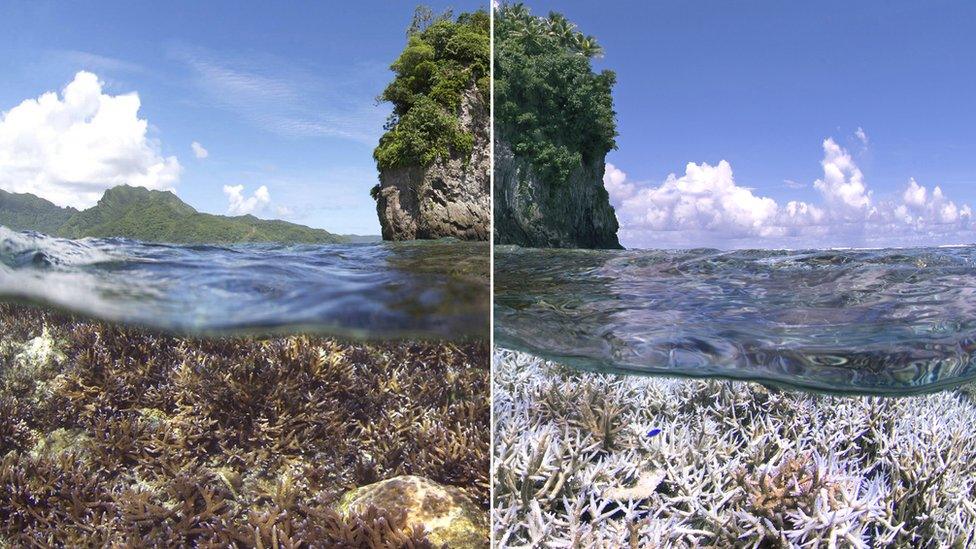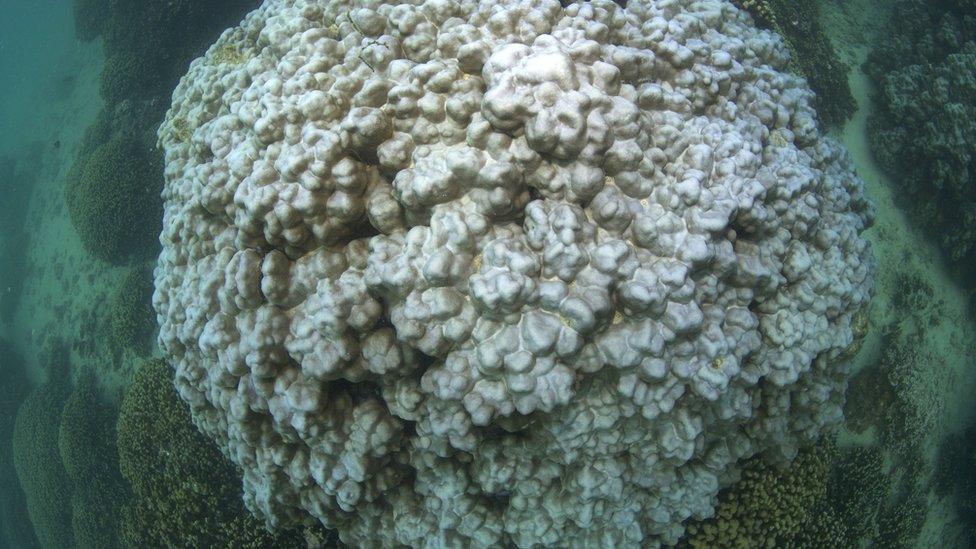Coral worldwide threatened by bleaching - NOAA
- Published
The world's coral reefs are at risk from a phenomenon called bleaching
Corals worldwide are at risk from a major episode of bleaching which turns reefs white, scientists have confirmed.
The bleaching has hit reefs in the Pacific, Atlantic and Caribbean.
The US National Oceanic and Atmospheric Administration (NOAA) warned it may affect over 38% of the world's reefs, and kill over 12,000 sq km of reefs.
The mass bleaching is caused by rising water temperatures resulting from two natural warm currents and exacerbated by man-made climate change.
Bleaching happens when corals under stress drive out the algae known as zooxanthellae that give them colour.
If normal conditions return, the corals can recover. But the process can take decades, and if the stress continues, the corals can die.

These images, taken in American Samoa, show the devastation caused by coral bleaching between December 2014 and February 2015
Reefs are under multiple threats including pollution, over-fishing, sedimentation and damage from boats and tourism.
The current worldwide bleaching episode is predicted to be the worst on record as the warming Pacific current, El Nino, increases in strength. Water temperatures are being driven further by a separate natural warm-water mass dubbed the Pacific Blob.
Man-made climate change also contributes, as the oceans are absorbing about 93% of the increase in the earth's heat.
Additionally, corals face ocean acidification as CO2 emissions are absorbed into the oceans, changing the pH of seawater.
Some scientists are warning that spectacular reefs as we know them - with branching corals and fan corals - are unlikely to survive changes in temperature and pH by the end of this century. That's if they are not killed first by other damaging local activities.
The current bleaching episode was predicted by NOAA and confirmed by researchers and citizen scientists in the Caribbean. The main groups involved are XL Catlin Seaview Survey, the University of Queensland, and Reef Check.

The current coral bleaching episode is the world's third major global coral bleaching event
Although reefs represent less than 0,1% of the world's ocean floor, they help support about a quarter of all marine species. The NOAA says the livelihoods of 500 million people and income worth over $30bn (£19,6bn) are at stake.
Reefs are the breeding ground for tropical fisheries. They also provide shelter from the waves for tropical islands and bring invaluable tourist income.
"Just like in 1998 and 2010, we're observing bleaching on a global scale, which will cause massive loss of corals. With people relying on fisheries and reefs for sustenance, the repercussions could be potentially disastrous," said Prof Ove Hoegh-Guldberg from the University of Queensland.
Prof Rupert Ormond, Secretary of the International Society for Reef Studies, told BBC News: "Although corals may live for several days after they bleach, they then usually die. They may recover - but only if the sea temperature drops within a week or so. Mostly it takes much longer, so the reef ends up covered with dead corals, especially on its upper parts.
"The reefs may slowly recover if new coral colonies come in from outside, but this may take years or decades. I know coral reefs in Kenya that lost most of their corals in 1998 and they still only have a few percent of the corals once there."
Follow Roger on Twitter @rharrabin , external
- Published11 January 2011
- Published16 July 2010